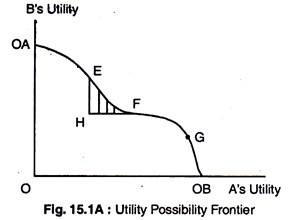The below mentioned article provides quick notes on utility possibilities frontier.
The utility possibilities frontier represents all allocations that are efficient and shows the level of satisfaction that each person achieves when he has traded to an efficient outcome, on the contract curve.
Points E, F, and G are points on the contract curve and are efficient. Point H is inefficient because any trade within the shaded area will make one or both people better-off as the Fig. 15.1A shows.
Suppose H and G are the only possible allocations. Is G more equitable than H? Not necessarily. Compared with H, G yields more utility for B and less for A. Some may feel that H is more equitable than G; others may feel the opposite. We conclude that one inefficient allocation may be more equitable than another efficient allocation.
ADVERTISEMENTS:
The problem is how to define an equitable allocation. Even if-we ourselves to all points are on the utility possibilities frontier, which point is more equitable? The answer depends on what one thinks equity entails, and, thus, on the interpersonal comparisons of utility that one is willing to make.
In economics, we use a social welfare function to describe the particular weights that are applied to each individual’s utility in determining what is socially desirable. The utilitarian concept weighs everyone’s utility equally and, consequently, maximises the total utility of all members.
Each social welfare function can be associated with a particular view about equity. But some views do not explicitly weighed individual utilities and cannot be represented by a social welfare function. For example, a market-oriented view argues that the outcome of the competitive market process is equitable because it rewards those who are most hard-working and able.
ADVERTISEMENTS:
If £is the competitive equilibrium allocation, it would be deemed to be more equitable than F, even though the goods are less equally allocated.
When more than two people are involved, the meaning of the word ‘equity’ becomes even more complex. The Rawlsian view emphasizes that an equal distribution of resources may remove the incentive that most productive, people have to work hard. This view allows inequalities, if these inequalities make the least-well-off person in society better-off.
According to Rawls, the most equitable allocation maximises the utility of the least-well-off person in society. The Rawlsian perspective could be egalitarian, involving an equal allocation of goods among all members of society, but it need not be.
Suppose by rewarding more productive people highly than less productive people, we can get the most productive people to work harder. This would produce more goods and services, some of which may be distributed to make the poorest members of society better-off.
